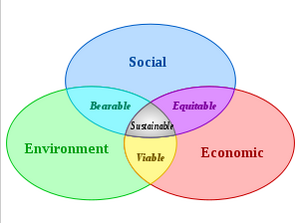
Venn diagram showing how sustainable development is at the confluence of three constituent parts
Definition[]
Sustainable development is defined, loosely, as development that does not fail. Thus, being sustainable. This means you are taking care of your present needs without destroying your economy or system in the future. Sustainable development allows an economy to grow and be successful in both the long run and the short run. Sustainable development is steady growth over a long period of time.
Corporations are also recognising the importance of incorporating sustainable development principles into their operations. Sustainable development is development that meets the needs of the present without compromising the ability of future generations to meet their own needs.
Sustainable development is a pattern of resource use that aims to meet human needs while preserving the environment so that these needs can be met not only in the present, but also for future generations.
A country does not have sustainable development if it is developing through the production/selling of primary/raw goods. The price tends to decrease as technology and other factors make it easier to obtain. Therefore these goods are not sustainable because they will continually decrease in value (the majority, at least, oil is one exception). Sooner or later, a country pursuing this type of growth, will fail. A country does have sustainable development if it is developing through the production/selling of secondary/tertiary goods. The demand for these goods is much more reliable than for the first type of goods. When a country makes the switch from primary goods production to secondary goods production, it is on its way to success.
Example[]
Many popular forms of energy are cheap, yet not sustainable resources. On the other hand, if you can grow a type of plant, and use that as fuel, that is sustainable as long as the plant is getting grown as fast as it is getting used (or if it CAN be grown as fast as it is being used.) Many "green" types of energy are sustainable because they are from sources of energy that don't run out in the relative long run, such as solar, wind or water. This is often one of the common things for a country to attempt to become sustainable energy-wise. Another example; if you have a runner who starts to run in a full sprint and a runner who jogs the runner who jogs will have more sustainability (this is actually an analogy not an example). A third example: A country moving from the production of primary/secondart goods to tertiary goods.